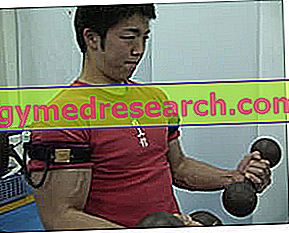The circumference of the arm is a widely used anthropometric measure, as it provides a quick estimate of the muscle mass of a subject. It is therefore used in sports, to monitor the athlete's degree of hypertrophy, but also in the health sector, to assess the loss or purchase of lean mass (malnutrition, rehabilitation after trauma or surgery, convalescence, etc.).
Arm circumference as a sign of malnutrition
| CLINICALLY SIGNIFICANT VALUES FOR MALNUTRITION | ||
| MALES | FEMALES | |
| ≥ 20.1 cm <22.8 cm | mild malnutrition | ≥ 18.6 cm <20.9 cm |
| > 15.2 cm <20.1 cm | average malnutrition | > 13.9 cm <18.6 |
| ≤ 15.2 cm | severe malnutrition | ≤ 13.9 cm |
Average arm circumference in healthy adults:
| MALES: | 32 ± 5 cm |
| FEMALES: | 28 ± 6 cm |
Arm circumference as an index of muscle mass
An indicator of simple detection and particularly useful for estimating lean mass is the measurement of the muscle circumference of the arm. To obtain this it is necessary to detect the skin fold at the level of the triceps (TS) and the circumference of the ipsilateral arm (AC).
The two data will be placed in the following equation:
Arm muscle circumference (AMC) = Cb - πP
Similarly, you can calculate the muscular area of the arm (AMA):
Arm muscle area (AMA) = (Cb - πP) 2 / 4π
total arm area (TAA)
Total arm area (TAA) = (Cb) 2 / 4π
and the fat area of the arm (AFA)
Adipose area of the arm (AFA) = TAA - AMA
These formulas are based on the assumption that the arm section is approximately circular, that the subcutaneous adipose layer is uniformly distributed around the muscle and that the contribution of the bone is constant in the different subjects. This is obviously a theoretical model, which is not reflected in reality; however, given the simplicity and diffusion of this technique, its limits are accepted.
How do you measure it?
The subject, with the upper limbs free of clothing, is in an upright position, the arms hang freely on the sides of the trunk and the palm of the hands is turned towards the thighs.
The circumference of the arm must be measured exactly at half the distance between acromion and olecranon, with a 90 ° flexed elbow, in the non-dominant arm. Consequently, it is necessary to locate the midpoint of the arm with the elbow flexed at 90 ° and with the palm of the hand facing upwards; once identified (with the aid of the metric tape), this point must be marked with a horizontal line of marker.
The subject is invited to reposition the arm to the side of the trunk and proceed with the detection (without compressing the soft tissues and keeping the meter perpendicular to the longitudinal axis of the limb, whose musculature must be relaxed).
The contracted biceps measurement (flexed arm circumference) is performed mainly by bodybuilders to monitor the degree of muscular hypertrophy; those who practice this sport at the highest level reach circumferences close to 55-60 cm.



